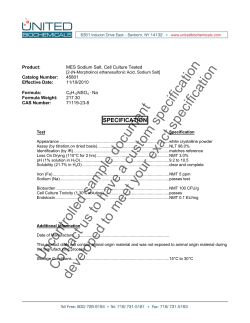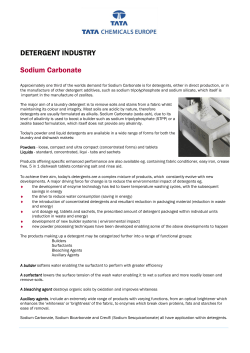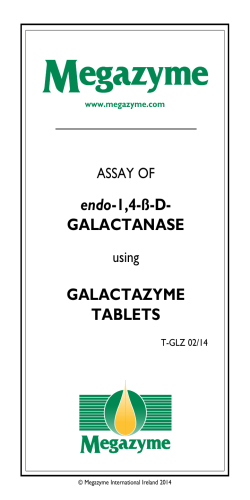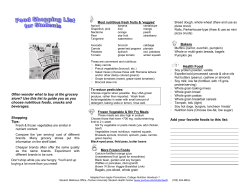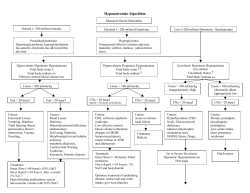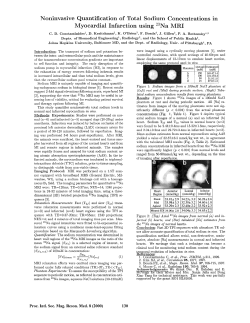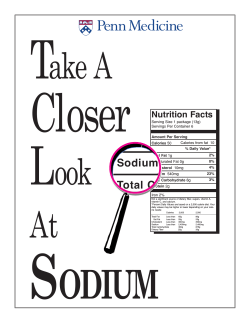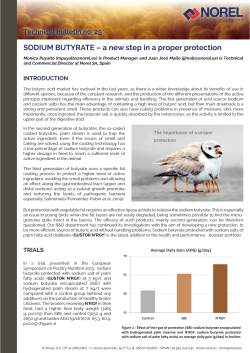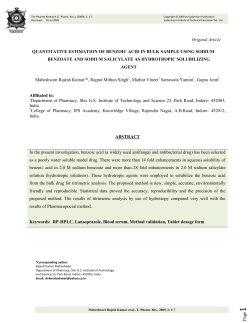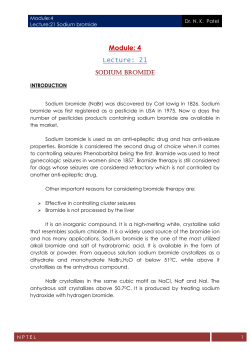
Document 259925
Diazyme Laboratories 12889 Gregg Court Poway, CA 92064, USA Tel: 858-455-4768 / Fax: 858-455-3701 Email: support@diazyme.com Website: www.diazyme.com Liquid Stable Sodium Enzymatic Assay Configuration The Diazyme Sodium reagent is provided in bulk and in the following kit configurations: Instrument Catalog No. Universal DZ114B-K Universal DZ114B-K01 Kit size R1: 4 x 40 mL R2: 4 x 20 mL Cal: 2 x 3 mL R1: 2 x 40 mL R2: 2 x 20 mL Cal: 2 x 3 mL Clinical Significance In healthy individual, an extracellular fluid level of sodium is regulated to maintain at 136 -146 mmole/L (313 -336 mg/dL1-2). Small deviations from normal level can have severe health consequences. Sodium has been commonly used in the diagnosis and management of patients with metabolic and cardiovascular disorder and is considered by American Association of Clinical Chemistry to have the potential of severe health consequences if left uncontrolled. Therefore monitoring serum sodium concentration is important in both routine check and emergency rooms. Assay Principle1 Sodium is determined enzymatically via sodium-dependent βgalactosidase activity with ONPG as substrate. The absorbance at 405 nm of the product O-nitrophenyl is proportional to the sodium concentration. Na+ Diazyme Normal and Abnormal Sodium Controls (DZ114B-CON) are recommended. Reagent Diazyme Liquid Stable Enzymatic Sodium Assay is intended for the quantitative in vitro determination of sodium in serum. Measurements obtained by this device are used in the diagnosis and treatment of aldosteronism (excessive secretion of the hormone aldosterone), diabetes insipidus (chronic excretion of large amounts of dilute urine, accompanied by extreme thirst), adrenal hypertension, Addison's disease (caused by destruction of the adrenal glands), dehydration, inappropriate antidiuretic hormone secretion, or other diseases involving electrolyte imbalance. β-galactosidase An analyzer capable of dispensing 2 reagents and of measuring absorbance at 405 nm with temperature control (37°C). Reagent Composition Intended Use ONPG Materials Required but not Provided O-nitrophenyl + galactose Composition Good’s buffer (pH 8.5) R1 Cryptand (>0.4 mM), β-D-galactosidase (<8 U/mL), Proclin 300 (0.02%) Good’s buffer (pH 6.5) R2 O-Nitrophenyl β-D- glycoside (>0.5 mM) Proclin 300 (0.02%) Buffered sodium Low Calibrator (Lot-specific value stated on vial) Buffered sodium High Calibrator (Lot-specific value stated on vial) Reagent Stability and Storage R1 and R2 are provided in ready-to-use liquid form and are stable until their expiry date when stored at 2 to 8°C. Low and High Calibrators Calibrators are supplied ready for use. The calibrators are stable up to expiration date marked on the label when stored at 2 to 8°C. Specimen Collection and Handling Serum is the recommended sample type for the Diazyme Sodium Assay. Precautions Do not pipette by mouth. Exercise the normal precautions required for handling laboratory reagents. Reagent R1 and R2 contain Proclin 300. Avoid ingestion or contact with skin or mucous membranes. In case of skin contact, flush affected area with copious amounts of water. In case of contact with eyes, or if ingested, seek immediate medical attention. Health and Safety Data Sheets are available on request. The reagents must be used only for the purpose intended by suitably qualified laboratory personnel, under appropriate laboratory conditions. Additional safety information concerning storage and handling of this product is provided within the Material Safety Data Sheet for this product. To obtain an MSDS, please contact our customer service department at 858-4554768. Automated Chemistry Analyzer Assay Scheme R1: 200 μL, Sample 8 µL ONPG = o-nitrophenyl -ß-D-galactopyranose R2: 100 µL 37oC 0 405 nm 2 A1 3 min A2 Distribuito in Italia da: Meridian Healthcare Tel. 095 725 68 69 Fax: 095 725 44 54 70247 Rev F Page 1 of 2 Effective: 06/10/09 Calibration Precision The use of Low and High Calibrators is recommended for calibration. A 2-point calibration is recommended every week, with change of reagent lot/bottle or as indicated by quality control procedures. The precision of the Diazyme Sodium Enzymatic Assay was evaluated according to NCCLS EP5-A guideline. In the study, two specimens containing 137 ± 13 mM and 160 ± 15 mM sodium were tested with 2 runs per day with duplicates over 10 working days.. The mean value (Mean), standard deviation, and between-day imprecision CV% are calculated and summarized in the following tables: This assay uses a linear calculation and a reagent blank. Ensure that: on the Calibration Checks screen, the following are selected for this test: Within Run Sampling Method for Calibrators • Duplicate Reagent Blank measurement • Enable Reagent Blank • Daily • Reagent Blank System Water Number of Data Points Mean (mM) SD (mM) CV% Quality Control Good laboratory practice recommends the use of control materials. Users should follow the appropriate federal, state and local guideline concerning the running of external quality control. Normal Level and High Level of serum controls are recommended for daily quality control. The two levels of controls should be assayed at least once a day. Values obtained should fall within a specified range. If these values fall outside the range and repetition excludes error, the following steps should be taken: 1. Check instrument settings and light source. 2. Check cleanliness of all equipment in use. 3. Check water; contaminants or bacterial growth may contribute to inaccurate results. 4. Check reaction temperature. 5. Check expiry date of kit and contents Level 1 (137±13mM sodium) 40 Level 2 (160± 15mM sodium) 40 128.94 1.57 1.2% 155.84 1.72 1.1% Level 1 (137±13mM sodium) 40 Level 2 (160± 15mM sodium) 40 128.94 2.01 1.56% 155.84 2.56 1.65% Total Number of Data Points Mean (mM) SD (mM) CV% Linearity This method is linear between sodium concentrations of 80 and 180 mmole/L (184 and 414 mg/dL). Limit of Detection The lower detection limit is 80 mM sodium. The higher detection limit is 180 mM sodium Results Sodium results are printed out in mmol/L. Interference Reference Range(2) 136 -146 mmole/L (313 -336 mg/dL) It is recommended that each laboratory establish its own reference range to reflect the age, sex, diet and geographical location of the population. Limitations When Sodium and Potassium are requested together, Sodium is assayed immediately before Potassium. Interference for the Diazyme Sodium Enzymatic Assay was evaluated on a Hitachi 717 analyzer. The following substances normally present in serum produced less than 10% deviation at the listed concentrations: NH4Cl at 1.5 mM, KPi at 2.0 mM, CaCl2 at 7.5 mM, KCl at 10 mM, CuCl2 at 0.5 mM, ZnCl2 at 0. 5 mM, FeCl3 at 0.5 mM, Glucose at 5 mM, ascorbate 10 mM, bilirubin at 40mg/dL, bilirubin conjugate 40 mg/dL, hemoglobin 500 mg/dL, and triglyceride 1000 mg/dL. References 1. Berry, M. N. et al., (1988) Clin. Chem. 34,2295 2. Tietz, N. W. (1983) Clinical guide to Laboratory Tests, p. 384 Performance Characteristics W.B. Saunders Co., Philadelphia Accuracy The performance of this assay was compared with the performance of a similar sodium assay on a Hitachi 717 analyzer using individual serum samples. Fifty-three serum samples ranging from 86.2 – 174.7 mmol/L gave a correlation coefficient of 0.98. Linear regression analysis gave the following equation: MDSS Schiffgraben 41 30175 Hannover, Germany 12889 Gregg Court Poway, CA 92064, USA Tel: (858) 455-4754 Fax: (858) 455-4750 This method = 1.05 (reference method) - 2.23 mmol/L Distribuito in Italia da: Meridian Healthcare Tel. 095 725 68 69 Fax: 095 725 44 54 70247 Rev F Page 2 of 2 Effective: 06/10/09
© Copyright 2025
